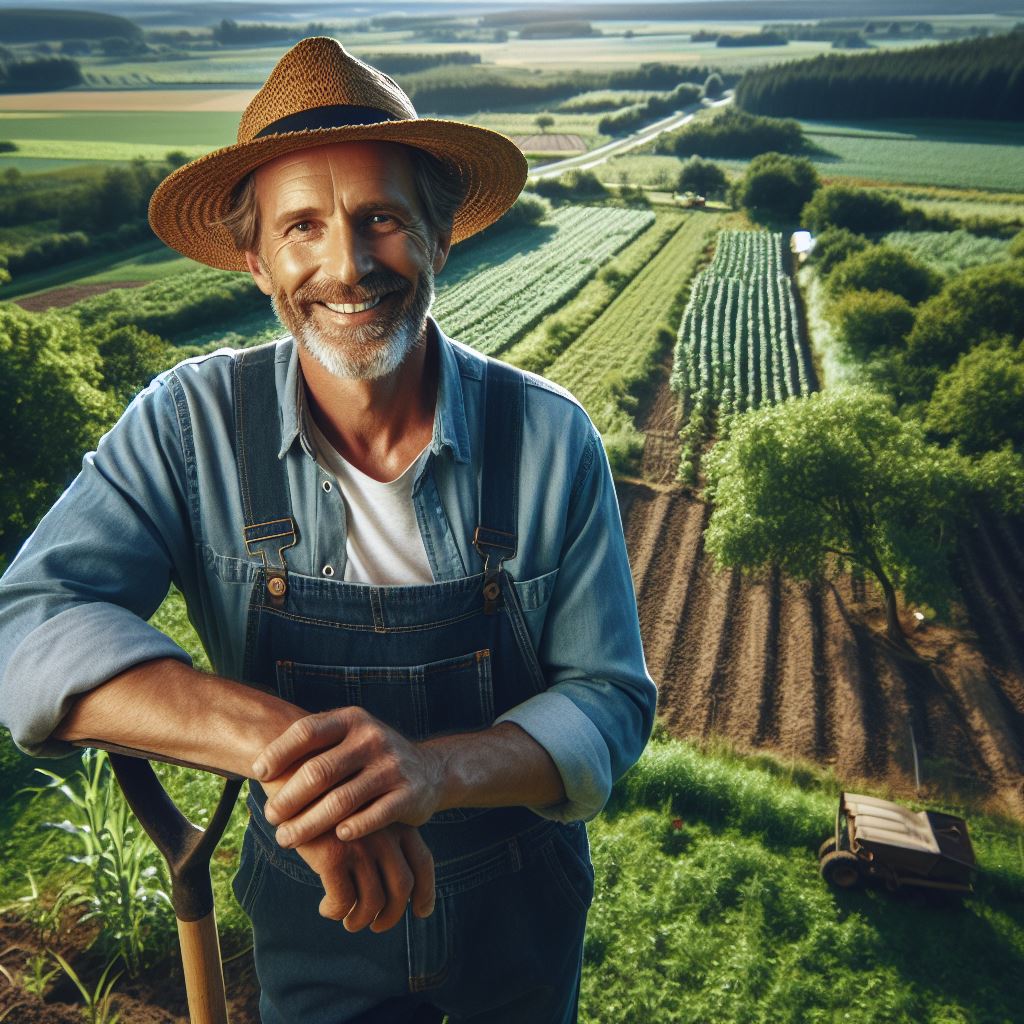Introduction
Eco-farming is the practice of sustainable agriculture that promotes environmental conservation and biodiversity.
Merging trees with crops is important as it provides numerous benefits, such as increased soil fertility and pest control.
This blog section will discuss the definition of eco-farming, the importance of merging trees with crops, and a preview of the points to be covered.
In the intricate tapestry of sustainable agricultural practices, one innovative approach stands out as a harmonious blend of nature’s elements — Eco-Farming.
This method intricately weaves together the vital components of trees and crops, creating a symbiotic relationship that transcends conventional farming boundaries.
As we delve into the realm of Eco-Farming, we uncover a nuanced strategy that not only promotes ecological balance but also maximizes agricultural efficiency.
In this exploration, we unravel the intricacies of merging trees with crops effectively, navigating the delicate balance between environmental stewardship and productive land use.
Join us on a journey through the verdant landscapes of Eco-Farming, where the union of nature and agriculture fosters sustainable practices for a thriving future.
Benefits of Merging Trees with Crops
Ecological benefits
Merging trees with crops offers numerous benefits that go beyond traditional farming methods.
This approach, also known as agroforestry, involves intentionally combining trees and crops in a mutually beneficial manner.
By actively incorporating trees into agricultural landscapes, farmers can reap various ecological and economic advantages.
Increased biodiversity
One of the significant ecological benefits of merging trees with crops is the increased biodiversity it promotes.
The presence of trees attracts a wide range of organisms, including beneficial insects, birds, and small mammals.
These organisms play essential roles in pollination, pest control, and overall ecosystem health.
With higher biodiversity, the farm becomes more resilient to disturbances and can better withstand fluctuations in environmental conditions.
Transform Your Agribusiness
Unlock your farm's potential with expert advice tailored to your needs. Get actionable steps that drive real results.
Get StartedEnhanced soil health and water retention
Furthermore, the combination of trees and crops enhances soil health and water retention.
Trees have long roots that penetrate deep into the ground, improving soil structure and nutrient availability.
They contribute organic matter through leaf litter, making the soil more fertile.
The presence of trees also helps prevent soil erosion, as their roots hold the soil in place and reduce water runoff.
This retention of water on the land reduces the need for irrigation, making agroforestry more sustainable and water-efficient.
Reduced need for synthetic inputs
Agroforestry practices also reduce the need for synthetic inputs like fertilizers and pesticides.
Trees serve as natural nutrient providers, cycling nutrients through their deep-rooted systems and enriching the soil.
This reduces the reliance on synthetic fertilizers, decreasing both financial costs for farmers and environmental pollution.
Additionally, the diverse habitats created by merging trees with crops attract beneficial insects that act as natural pest control agents, reducing the need for chemical pesticides.
Economic benefits
Diversification and risk reduction
The merging of trees and crops brings significant economic benefits to farmers.
Diversification is key to mitigating risks associated with changing market demands and climate uncertainties.
By integrating trees into farming systems, farmers can diversify their income streams.
They can sell timber, fruits, nuts, or other non-timber forest products alongside their crops, providing additional sources of revenue. This diversification helps stabilize income and reduces vulnerability to market fluctuations.
Added value to crops
Moreover, the presence of trees adds value to the crops grown. Consumers often perceive agroforestry products as more sustainable, ethical, and of higher quality.
This perception creates an opportunity to market crops at premium prices, increasing the profitability for farmers.
Opportunities for agroforestry enterprises
Additionally, merging trees with crops opens doors to the development of agroforestry enterprises, such as agroforestry nurseries or value-added processing of agroforestry products.
These enterprises can generate further income and employment opportunities for farmers and rural communities.
In short, the merging of trees with crops offers a range of ecological and economic benefits.
Increased biodiversity, enhanced soil health, reduced synthetic inputs, diversification, added value to crops, and opportunities for agroforestry enterprises are just a few advantages of this innovative approach.
As the importance of sustainable and resilient agricultural practices grows, agroforestry proves to be a promising solution that not only improves the environment but also provides economic prosperity for farmers.
Read: Agroforestry 101: Basics for Sustainable Land Use
Strategies for Effective Tree-Crop Integration
Agroforestry systems play a crucial role in merging trees with crops effectively.
This innovative approach combines agricultural practices with forestry techniques to create sustainable and efficient farming systems.
By implementing agroforestry systems, farmers can improve land productivity, conserve natural resources, and enhance biodiversity.
Showcase Your Farming Business
Publish your professional farming services profile on our blog for a one-time fee of $200 and reach a dedicated audience of farmers and agribusiness owners.
Publish Your ProfileStrategies for Effective Tree-Crop Integration
One popular agroforestry system is alley cropping. This technique involves planting crops in between rows of trees, forming a productive and harmonious relationship between the two.
The trees provide shade, reducing soil erosion and optimizing water use, while the crops benefit from the protection and nutrient cycling provided by the trees.
This system offers a more efficient use of land, as both trees and crops can be cultivated simultaneously.
Silvopasture is another effective agroforestry system. It involves integrating trees with livestock grazing, providing multiple benefits.
Trees offer shade for the animals, reducing heat stress, and improving their welfare.
Moreover, the trees contribute to forage production, offering additional food resources for the livestock.
Silvopasture systems help farmers optimize land use, increase productivity, and enhance the sustainability of their operations.
Forest farming is a unique agroforestry system that involves cultivating high-value crops within forested areas.
This system allows farmers to capitalize on the natural resources offered by forests while diversifying income streams.
Medicinal herbs, mushrooms, and specialty timber can be cultivated in these forested areas, providing additional revenue opportunities.
Forest farming contributes to forest conservation efforts while generating profits for farmers.
Selecting appropriate tree and crop species
Selecting appropriate tree and crop species is crucial to the success of tree-crop integration. Farmers should consider compatible characteristics when choosing species.
Trees and crops with similar soil, water, and sunlight requirements are more likely to thrive together.
This ensures that both the trees and crops receive the necessary resources for optimal growth and productivity.
Complementary growth patterns and resource use are also essential considerations.
Pairing trees and crops that utilize different resources minimizes competition and maximizes resource efficiency.
For example, deep-rooted trees can access nutrients and water from lower soil layers, while shallow-rooted crops can utilize resources from the topsoil. This symbiotic relationship ensures efficient resource utilization and minimizes resource depletion.
Market demand and profitability considerations are vital factors when selecting tree and crop species.
Farmers should research and identify species that have high market demand and potential profitability.
Moreover, by aligning tree and crop choices with market demands, farmers can optimize their income and ensure long-term sustainability.
In fact, tree-crop integration through agroforestry systems offers a sustainable and effective approach to farming.
By implementing systems such as alley cropping, silvopasture, and forest farming, farmers can maximize land use, conserve resources, and enhance biodiversity.
Selecting appropriate tree and crop species based on compatible characteristics, complementary growth patterns, and market demand considerations further contributes to the success of tree-crop integration.
Embracing these strategies and techniques will lead to a more sustainable and productive agricultural sector.
Read: The Economics of IPM in Agriculture

Challenges and Solutions
Eco-farming, which involves merging trees with crops, brings several challenges that need to be addressed for its successful implementation.
These challenges primarily revolve around the competition for resources, tree maintenance, and management, as well as market acceptance and consumer education.
Competition for resources
- To ensure the success of merging trees with crops, it is crucial to manage the competition for essential resources such as light, nutrients, and water. Both trees and crops require these resources for optimal growth and productivity.
- Managing tree-crop spacing and density becomes essential to balance their resource requirements effectively. The arrangement should allow adequate access to resources for both trees and crops without compromising their growth and development.
- Integrated pest and disease management plays a vital role in overcoming challenges related to maintaining plant health in tree-crop systems. Implementing effective strategies to minimize pest and disease impacts is crucial for ensuring a sustainable and productive eco-farming environment.
Tree maintenance and management
- Pruning and shaping trees is a critical practice to maintain their health, productivity, and proper canopy development. Regular pruning ensures that resources are distributed efficiently and reduces the risk of pests and diseases.
- Efficient harvesting and processing methods need to be developed to optimize the yield of both tree products and crops. Proper post-harvest management ensures the quality and market value of the final products.
- Long-term tree care practices, including regular maintenance and replanting, are necessary to sustain the ecological balance in eco-farmed systems. It is essential to replant trees as needed and ensure their long-term care for the continued success of the eco-farming approach.
Market acceptance and consumer education
- Promoting the benefits of eco-farmed products is crucial for enhancing their market acceptance. Educating consumers about the positive environmental and health impacts of eco-farming can encourage their preference for such products.
- Building consumer trust and awareness is key in the success of eco-farming. Transparent labeling and certification processes provide consumers with the necessary information and assurance regarding the eco-friendly practices adopted in the production of eco-farmed products.
- Collaboration with local communities and organizations can aid in creating awareness about eco-farming. By involving stakeholders and fostering partnerships, eco-farming practices can be promoted, and its advantages can be shared with a wider audience.
In general, eco-farming brings numerous advantages by merging trees with crops. However, it also presents challenges that require innovative solutions.
Addressing the competition for resources, ensuring effective tree maintenance and management, and promoting market acceptance through consumer education are vital for the success and growth of eco-farming.
Moreover, by overcoming these challenges, eco-farming can play a significant role in promoting sustainable agriculture and environmental conservation.
Read: IPM Training: Empowering Sustainable Farmers
Case Studies of Successful Eco-Farming Practices
Example 1: White Dog Farm’s Agroforestry Model
Design and implementation
White Dog Farm, located in a rural area, created an agroforestry model that combined the cultivation of crops with strategically planted trees.
Achieved ecological and economic outcomes
This innovative approach promoted biodiversity, reduced soil erosion, and increased the farm’s overall productivity.
Lessons learned and recommendations
White Dog Farm emphasized the importance of proper tree selection, species diversity, and regular monitoring for long-term success.
Example 2: Organic Valley Co-op’s Forest Farming Initiative
Cooperative structure and member involvement
Organic Valley Co-op implemented a forest farming initiative in collaboration with its members, involving them in decision-making processes.
Marketing and distribution strategies
The co-op developed effective marketing and distribution strategies, ensuring the successful sale and distribution of forest-based products.
Positive impacts on local community and environment
This initiative provided additional income for members, preserved forests, and enhanced the regional ecosystem through sustainable farming practices.
In recent years, ecologically-minded farmers have successfully combined the benefits of trees and crops in their farming practices.
These case studies showcase the achievements and learnings of two successful eco-farming initiatives.
Example 1: White Dog Farm’s Agroforestry Model
White Dog Farm, a rural farm, embraced an agroforestry model that integrated tree cultivation with traditional crop farming.
Showcase Your Farming Business
Publish your professional farming services profile on our blog for a one-time fee of $200 and reach a dedicated audience of farmers and agribusiness owners.
Publish Your ProfileThrough careful design and implementation, they ensured a balanced synergy between trees and crops, harnessing the benefits of both.
This approach not only increased biodiversity on the farm but also reduced soil erosion, contributing to a more sustainable and resilient ecosystem.
The farm witnessed a boost in overall productivity, demonstrating the economic viability of eco-farming practices.
To achieve such positive outcomes, White Dog Farm highlighted the importance of selecting the right tree species and ensuring diversity within the planted trees.
They emphasized the need for regular monitoring of tree health and growth, allowing timely interventions and adaptation of management strategies.
These lessons learned can serve as valuable recommendations for other farmers looking to adopt similar agroforestry models successfully.
Example 2: Organic Valley Co-op’s Forest Farming Initiative
Another inspiring case study in the realm of eco-farming is the forest farming initiative led by Organic Valley Co-op.
This cooperative structure engaged its members in decision-making processes, fostering a sense of ownership and empowerment.
Together, they created a flourishing ecosystem where forest-based products were cultivated sustainably, enhancing both income and environmental resilience.
Effective marketing and distribution strategies played a crucial role in Organic Valley Co-op’s success.
The co-op ensured that forest-based products gained market visibility and were easily accessible to consumers.
By leveraging their reputation as an organic and sustainable organization, they established a strong presence in the market, boosting sales and demand for forest-derived products.
This forest farming initiative also positively impacted the local community and environment.
It provided additional income sources for the co-op members, contributing to a more stable and prosperous community.
Moreover, the preserved forests enhanced the region’s ecological balance, promoting habitat diversity and supporting local wildlife populations.
In a nutshell, these two case studies highlight successful eco-farming practices that amalgamate trees and crops effectively.
Moreover, by incorporating trees into their farming systems, these farmers achieved remarkable ecological and economic outcomes.
The lessons learned and recommendations from these examples can inspire and guide other farmers toward sustainable and profitable eco-farming models.
Through continued exploration and implementation of such practices, we can foster a more environmentally conscious and resilient agricultural sector.
Read: IPM: Reducing Pesticides, Boosting Yields
Conclusion
Throughout this blog section, we have explored the concept of eco-farming and the importance of merging trees with crops effectively.
We discussed how eco-farming can contribute to sustainable agriculture and environmental conservation.
We highlighted the benefits of tree-crop integration, such as enhanced soil fertility, improved biodiversity, and increased resilience to climate change.
Effective tree-crop integration is crucial in eco-farming as it promotes a harmonious and symbiotic relationship between trees and crops.
Moreover, by strategically planting trees on farms, farmers can create microclimates, provide shade, control pests, and reduce the use of synthetic inputs.
Furthermore, tree-crop integration supports the overall health and productivity of agroecosystems, making them more resilient and sustainable in the long run.
It is essential for farmers and policymakers to recognize the value of eco-farming and actively embrace it as a sustainable agricultural approach.
Investing in research, education, and support systems that promote eco-farming practices can lead to increased adoption and its widespread implementation.
Moreover, by supporting and incentivizing eco-farming, we can protect our environment, improve food security, and foster sustainable economic development.
Effective tree-crop integration is a key aspect of eco-farming that offers numerous benefits both to farmers and the environment.
It is our responsibility to prioritize and promote eco-farming practices for a more sustainable and resilient future.




